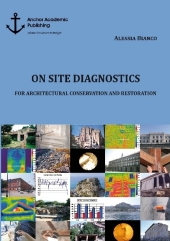 Neuerscheinungen 2017Stand: 2020-02-01 |
Schnellsuche
ISBN/Stichwort/Autor
|
Herderstraße 10
10625 Berlin
Tel.: 030 315 714 16
Fax 030 315 714 14
info@buchspektrum.de |

Alessia Bianco
On Site Diagnostics for Architectural Conservation and Restoration
2017. 380 S. 730 Abb. 270 mm
Verlag/Jahr: ANCHOR ACADEMIC PUBLISHING 2017
ISBN: 3-9606715-4-7 (3960671547)
Neue ISBN: 978-3-9606715-4-1 (9783960671541)
Preis und Lieferzeit: Bitte klicken
The topic of on site diagnostics for historical, monumental and vernacular architecture is characterized by a twofold difficulty, partially due to a sort of hiatus between the scientific community and a professional system. In fact, on one side universities and research centres produce advanced technologies, methodologies and procedures, but they are not always adequately disseminated among professionals and are sometimes inconsistent with some relevant criteria, such as feasibility and cost-effectiveness. On the other side, professionals, in the field of on site diagnostics for historical architectures, are holding a heritage, made of experiences and practice, which often is not enough shared and sometimes is contrasting with the limited possibilities to evaluate and verify the professional training and certification system, which seems too heterogeneous, if compared to other high scientific and technical professions, as is the case, for example, in medicine or engineering.
In this book, the diagnostic experiences are described, though, for logistical reasons, often briefly, following a systematic methodological approach, according to three of the main steps for the knowledge of historical buildings: anamnesis, diagnosis and prognosis, obviously with particular attention to the specifically diagnostic issues (diagnosis), but framed in the preliminary diagnostic plan and interpreted in the light of the performance, prefigured in the preliminary stages and connected to the visual inspection. That is why this book regards not only some experimental, unconventional and innovative diagnostic surveys and diagnostic experiences, carried out on particularly valuable monumental buildings under the historical-architectural point of view, but also ordinary and simple experiences in the field of professional diagnostic practice, where, however, it was possible to apply the methodology and the know-how, acquired and systematized in the performance of the experimental diagnostic surveys, often included in wider scientific research projects. This book is not exclusively addressing the scientific and academic community, but it also pursues the aim of disseminating in the professional system a heritage of rather varied experimental researches and practical experiences, but methodologically oriented toward a culture, which considers the design of diagnostic plans as a regulation criterion for quality control of professionals.


